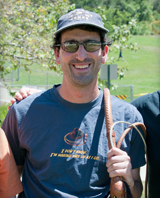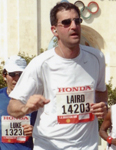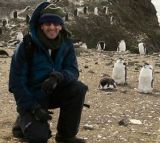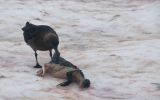
-CIA- World Factbook
-Cool Antarctica
-Discovering Antarctica
-FrankHurley.org

Laird's Bio

Follow Laird at
RunLairdRun.com

Support One of
Laird's Charities
Chapter 12 | Chapter 13 | Chapter 14

Continuing on our way from the landing zone, we followed orange flags laid out by the crew to keep us safely back from the animals. Studies have been done for years about the impact of tourism on the natural fauna. Every landing area contains both open areas and control (restricted) areas. The main non-profit organization counting and checking the impact, Oceanites (www.oceanites.org), is the official charity of the race. So far, tourism is somehow promoting reproduction in some of the penguin populations. At best, tourism is not harmful to the wildlife in the conscientious manner in which the International Association for Antarctica Tour Operators (IAATO) run their ships. In fact, many people (mostly the tour operators) feel that tourism has benefited Antarctica because the scientists are being held to higher standards for pollution control than prior to the continent being open. Whatever the case, we had to sign off on multiple letters of acknowledgement of how to behave when on land.
Reaching the base of a glacier, we then were allowed to climb up above the beach. This 30 degree hill wasn't too challenging as we kicked out steps in the loose snow/ice top layer. And oh what a view! More of the glacier reached above us. Icebergs and floes drifted in the harbor. Penguins and seals bobbed up and down in the water at the sea's edge. A cadre of penguins moved up and down the slope without much difficulty - and definitely less than we had. In the past two landings, the smell of the penguin guano had been intense, but it was so windy today that I don't think any smell could have stuck around. Ice crystals pelted our exposed faces.
Our ears were treated to new sounds as well. Penguins communicate with squeaks and each is unique. Parents can tell their children by sound alone even amongst thousands of other penguins. To us, they all sound the same, but those squawks are loud and constant. In a lower register, sounds of cracks, pops and rumbles reminded us that the glaciers were all still moving - some as fast as 30 meters in a month. When huge chunks break off, they become those lovely icebergs we see in the ocean. More than one Zodiac (but none on our trip) has been knocked over by the small tidal wave caused by the crash of ice into the ocean. The whistling wind completed the auditory landscape.
Before I leave everyone with the impression of a winter paradise, let me say that the conditions were tough. The normal landing spot for this area was completely packed with ice. The alternate we used was barely big enough to give us room to navigate by the penguins. But walking on Antarctica is so unique and special, that the Quark Expedition staff who runs the boat know they have to do everything they can to make it work. In fact, if you read Chapter Eleven, you know we had a delay just awaiting the winds to simmer down from a gale to something the Zodiacs could stay upright in.
And the safety of the animals is really something we aim to do by visiting responsibly; this is, after all a, wilderness. Thus you see signs of the predatory nature of different creatures. Before we landed on the beach, we zipped around the icebergs in the harbor. On one floe laid a gray seal, a big scar laced its back obvious in the morning gloom. A bigger seal or perhaps a squid had inflicted that wound.
Even more glaringly obvious, up on the glacier, a skua bird munched happily on the carcass of a gentoo penguin. This oddly gruesome and yet hypnotic site plays itself out every day. Sometimes the cause is a chick not being fed by its parents; sometimes the parents themselves favor one chick over another. (Gentoo, adelie and chinstrap penguins - the types in this part of Antarctica - all lay two eggs as compared to the more famous emperor penguins' solo chick featured in March of the Penguins.)
This part of the peninsula has seen more snow than usual. The result being that breeding started later and therefore less time existed for parents to go out and bring food back to their young. If the young do not get strong enough, they cannot learn to swim and hunt for their own krill and fish. The lateness of the breeding season means the time to get this done before the penguins have to migrate is shorter. Plus, after the parents fatten up their young, they need to completely molt off their feathers for a new coat. This takes three weeks during which they do not feed. Besides going hungry from not eating, the molting process is intense as massive amounts of proteins are created to build the new layers. We were given specific instructions to stay away from molting penguins because they are already stressed enough.
Gentoo and chinstraps fall into the category of sub-antarctic penguins because they also show up in South America, The Falkland Islands, New Zealand and Australia. Adelie penguins are true antarctic ones as they do not live north of 60 degree latitude.
If you have visited penguins in the zoo or a marine park or even watched them on film, you know they move by shuffling back and forth. In person, this can only make you laugh, even as they try to eat your backpack strap or peck at your waterproof boots (while we have to stay back from penguins, they can come up to us if they so choose). Sometimes you see one chasing another, or a more gentle moment of a mom feeding a chick. Occasionally, a clearly abandoned chick lies despondingly away from the main rookery. Death seems certain in this case.
But fortunately the penguins (and seals for that matter) are doing well. Penguins have never really proven to be appetizing or worth their pelts, so hunters have left them alone. All animals in the Antarctic are legally protected internationally and by specific laws in many countries including the United States. But 150 years ago, whalers and sealers were the first to make any significant inroads into visiting this place. In fact, the first scientific or nationalistic journeys did not start until 1898 when the Belgians spent the first supposedly planned winter in the continent. With that success achieved, many countries embarked upon journeys. But prior to that, an active whaling and sealing season harvested the animals for all aspects of their masses. Seal pelts were quite popular in fashionable circles. Whale and seal blubber could be used for fuel and cosmetics. Whale meat was considered a delicacy. The earliest stations and buildings - primarily on the sub-antarctic islands such as South Georgia - were built to support these voyages with fuel depots, processing stations and winter respites.
Looking back through 20-20 hindsight, one can easily condemn this brutality, but not many people spoke out at the time. Today those activities are banned by treaty, although some illegal actions do still occur.
I cannot stress how fortunate I am to be here to report these idea, feelings and facts. So, as I hear the anchor drop as we reach Port Lockroy museum for a short visit, I'll sign off.
Thanks for reading. Next up: Photography in Antarctica - Following in the footsteps of Frank Hurley.
Back to the Top
Chapter 12 | Chapter 13 | Chapter 14




